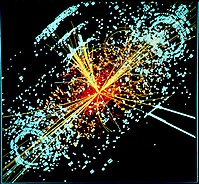
Photo from wikipedia
Abstract With updated experimental data and improved theoretical calculations, several significant deviations are being observed between the Standard Model predictions and the experimental measurements of the branching ratios of $$… Click to show full abstract
Abstract With updated experimental data and improved theoretical calculations, several significant deviations are being observed between the Standard Model predictions and the experimental measurements of the branching ratios of $$ {\overline{B}}_{(s)}^0\to {D}_{(s)}^{\left(\ast \right)+}{L}^{-} $$ B ¯ s 0 → D s ∗ + L − decays, where L is a light meson from the set {π, ρ, K(∗)}. Especially for the two channels $$ {\overline{B}}^0\to {D}^{+}{K}^{-} $$ B ¯ 0 → D + K − and $$ {\overline{B}}_s^0\to {D}_s^{+}{\pi}^{-} $$ B ¯ s 0 → D s + π − , both of which are free of the weak annihilation contribution, the deviations observed can even reach 4–5σ. Here we exploit possible new-physics effects in these class-I non-leptonic B-meson decays within the framework of QCD factorization. Firstly, we perform a model-independent analysis of the effects from twenty linearly independent four-quark operators that can contribute, either directly or through operator mixing, to the quark-level b →$$ c\overline{u}d(s) $$ c u ¯ d s transitions. It is found that, under the combined constraints from the current experimental data, the deviations observed could be well explained at the 1σ level by the new-physics four-quark operators with γμ(1 − γ5) ⨂ γμ(1 − γ5) structure, and also at the 2σ level by the operators with (1 + γ5) ⨂ (1 − γ5) and (1 + γ5) ⨂ (1 + γ5) structures. However, the new-physics four-quark operators with other Dirac structures fail to provide a consistent interpretation, even at the 2σ level. Then, as two specific examples of model-dependent considerations, we discuss the case where the new-physics four-quark operators are generated by either a colorless charged gauge boson or a colorless charged scalar, with their masses fixed both at the 1 TeV. Constraints on the effective coefficients describing the couplings of these mediators to the relevant quarks are obtained by fitting to the current experimental data.
Journal Title: Journal of High Energy Physics
Year Published: 2021
Link to full text (if available)
Share on Social Media: Sign Up to like & get
recommendations!